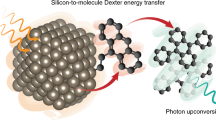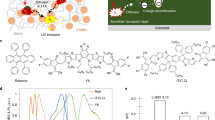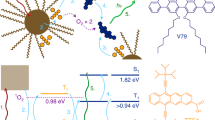Abstract
Hybrid structures formed between organic molecules and inorganic quantum dots can accomplish unique photophysical transformations by taking advantage of their disparate properties. The electronic coupling between these materials is typically weak, leading photoexcited charge carriers to spatially localize to the dot or to a molecule at its surface. However, we show that by converting a chemical linker that covalently binds anthracene molecules to silicon quantum dots from a carbon–carbon single bond to a double bond, we access a strong coupling regime where excited carriers spatially delocalize across both anthracene and silicon. By pushing the system to delocalize, we design a photon upconversion system with a higher efficiency (17.2%) and lower threshold intensity (0.5 W cm–2) than that of a corresponding weakly coupled system. Our results show that strong coupling between molecules and nanostructures achieved through targeted linking chemistry provides a complementary route for tailoring properties in materials for light-driven applications.

This is a preview of subscription content, access via your institution
Access options
Access Nature and 54 other Nature Portfolio journals
Get Nature+, our best-value online-access subscription
$29.99 / 30 days
cancel any time
Subscribe to this journal
Receive 12 print issues and online access
$259.00 per year
only $21.58 per issue
Buy this article
- Purchase on Springer Link
- Instant access to full article PDF
Prices may be subject to local taxes which are calculated during checkout





Similar content being viewed by others
Data availability
Source data are provided with this paper. Additional source data for figures contained in the Supplementary Information are available from the authors upon request.
References
Brett, M. W., Gordon, C. K., Hardy, J. & Davis, N. J. L. K. The rise and future of discrete organic–inorganic hybrid nanomaterials. ACS Phys. Chem. Au 2, 367–387 (2022).
Garakyaraghi, S. & Castellano, F. N. Nanocrystals for triplet sensitization: molecular behavior from quantum-confined materials. Inorg. Chem. 57, 2351–2359 (2018).
Huang, Z. & Tang, M. L. Semiconductor nanocrystal light absorbers for photon upconversion. J. Phys. Chem. Lett. 9, 6198–6206 (2018).
Frederick, M. T., Amin, V. A. & Weiss, E. A. Optical properties of strongly coupled quantum dot−ligand systems. J. Phys. Chem. Lett. 4, 634–640 (2013).
Lu, H. et al. Transforming energy using quantum dots. Energy Environ. Sci. 13, 1347–1376 (2020).
Rao, A. & Friend, R. H. Harnessing singlet exciton fission to break the Shockley–Queisser limit. Nat. Rev. Mater. 2, 17063 (2017).
Kroupa, D. M. et al. Control of energy flow dynamics between tetracene ligands and PbS quantum dots by size tuning and ligand coverage. Nano Lett. 18, 865–873 (2018).
Allardice, J. R. et al. Engineering molecular ligand shells on quantum dots for quantitative harvesting of triplet excitons generated by singlet fission. J. Am. Chem. Soc. 141, 12907–12915 (2019).
Lu, H., Chen, X., Anthony, J. E., Johnson, J. C. & Beard, M. C. Sensitizing singlet fission with perovskite nanocrystals. J. Am. Chem. Soc. 141, 4919–4927 (2019).
Han, Z., Qiu, F., Eisenberg, R., Holland, P. L. & Krauss, T. D. Robust photogeneration of H2 in water using semiconductor nanocrystals and a nickel catalyst. Science 338, 1321–1324 (2012).
Imperiale, C. J., Green, P. B., Hasham, M. & Wilson, M. W. B. Ultra-small PbS nanocrystals as sensitizers for red-to-blue triplet-fusion upconversion. Chem. Sci. 12, 14111–14120 (2021).
Jiang, Y., Wang, C., Rogers, C. R., Kodaimati, M. S. & Weiss, E. A. Regio- and diastereoselective intermolecular [2+2] cycloadditions photocatalysed by quantum dots. Nat. Chem. 11, 1034–1040 (2019).
Jiang, Y. & Weiss, E. A. Colloidal quantum dots as photocatalysts for triplet excited state reactions of organic molecules. J. Am. Chem. Soc. 142, 15219–15229 (2020).
Brown, K. A., Dayal, S., Ai, X., Rumbles, G. & King, P. W. Controlled assembly of hydrogenase-CdTe nanocrystal hybrids for solar hydrogen production. J. Am. Chem. Soc. 132, 9672–9680 (2010).
Mongin, C., Moroz, P., Zamkov, M. & Castellano, F. N. Thermally activated delayed photoluminescence from pyrenyl-functionalized CdSe quantum dots. Nat. Chem. 10, 225–230 (2018).
Wu, M. et al. Solid-state infrared-to-visible upconversion sensitized by colloidal nanocrystals. Nat. Photon. 10, 31–34 (2015).
Huang, Z. et al. Hybrid molecule–nanocrystal photon upconversion across the visible and near-infrared. Nano Lett. 15, 5552–5557 (2015).
Marcus, R. A. On the theory of oxidation-reduction reactions involving electron transfer. I. J. Chem. Phys. 24, 966–978 (1956).
Forster, T. Zwischenmolekulare energiewanderung und fluoreszenz. Ann. Phys. 6, 55–75 (1938).
Dexter, D. L. A theory of sensitized luminescence in solids. J. Chem. Phys. 21, 836 (1953).
Frederick, M. T., Amin, V. A., Cass, L. C. & Weiss, E. A. A molecule to detect and perturb the confinement of charge carriers in quantum dots. Nano Lett. 11, 5455–5460 (2011).
Westmoreland, D. E., López-Arteaga, R. & Weiss, E. A. N-heterocyclic carbenes as reversible exciton-delocalizing ligands for photoluminescent quantum dots. J. Am. Chem. Soc. 142, 2690–2696 (2020).
Lian, S., Weinberg, D. J., Harris, R. D., Kodaimati, M. S. & Weiss, E. A. Subpicosecond photoinduced hole transfer from a CdS quantum dot to a molecular acceptor bound through an exciton-delocalizing ligand. ACS Nano 10, 6372–6382 (2016).
He, S. et al. Engineering sensitized photon upconversion efficiency via nanocrystal wavefunction and molecular geometry. Angew. Chem. Int. Ed. 59, 17726–17731 (2020).
Xia, P. et al. On the efficacy of anthracene isomers for triplet transmission from CdSe nanocrystals. Chem. Commun. 53, 1241–1244 (2017).
Yanai, N. & Kimizuka, N. New triplet sensitization routes for photon upconversion: thermally activated delayed fluorescence molecules, inorganic nanocrystals, and singlet-to-triplet absorption. Acc. Chem. Res. 50, 2487–2495 (2017).
Nienhaus, L. et al. Speed limit for triplet-exciton transfer in solid-state PbS nanocrystal-sensitized photon upconversion. ACS Nano 11, 7848–7857 (2017).
Xia, P. et al. Achieving spin-triplet exciton transfer between silicon and molecular acceptors for photon upconversion. Nat. Chem. 12, 137–144 (2020).
Carroll, G. M., Limpens, R. & Neale, N. R. Tuning confinement in colloidal silicon nanocrystals with saturated surface ligands. Nano Lett. 18, 3118–3124 (2018).
Dohnalova, K., Saeed, S., Poddubny, A. N., Prokofiev, A. A. & Gregorkiewicz, T. Thermally activated emission from direct bandgap-like silicon quantum dots. ECS J. Solid State Sci. Technol. 2, R97–R99 (2013).
Anthony, R. J., Cheng, K.-Y., Holman, Z. C., Holmes, R. J. & Kortshagen, U. R. An all-gas-phase approach for the fabrication of silicon nanocrystal light-emitting devices. Nano Lett. 12, 2822–2825 (2012).
Li, Z. & Kortshagen, U. R. Aerosol-phase synthesis and processing of luminescent silicon nanocrystals. Chem. Mater. 31, 8451–8458 (2019).
Leung, K. & Whaley, K. B. Electron-hole interactions in silicon nanocrystals. Phys. Rev. B 56, 7455–7468 (1997).
Montalti, M., Credi, A., Prodi, L. & Gandolfi, M. T. Handbook of Photochemistry 3rd edn (CRC Press/Taylor and Francis, 2006).
Birks, B. & Slifkin, M. A. π-Electronic excitation and ionization energies of condensed ring aromatic hydrocarbons. Nature 191, 761–764 (1961).
Clarke, R. H. & Hochstrasser, R. M. Location and assignment of the lowest triplet state of perylene. J. Mol. Spectrosc. 32, 309–319 (1969).
Albrecht, W. G., Michel-Beyerle, M. E. & Yakhot, V. Exciton fission in excimer forming crystal. Dynamics of an excimer build-up in α-perylene. Chem. Phys. 35, 193–200 (1978).
Giri, G., Prodhan, S., Pati, Y. A. & Ramasesha, S. A model exact study of the properties of low-lying electronic states of perylene and substituted perylenes. J. Phys. Chem. A 122, 8650–8658 (2018).
Evans, D. F. Perturbation of singlet–triplet transitions of aromatic molecules by oxygen under pressure. J. Chem. Soc. 1957, 1351–1357 (1957).
Follstaedt, D. M. Relative free energies of Si surfaces. Appl. Phys. Lett. 62, 1116–1118 (1993).
Jaccodine, R. J. Surface energy of germanium and silicon. J. Electrochem. Soc. 110, 524 (1963).
Eaglesham, D. J., White, A. E., Feldman, L. C., Moriya, N. & Jacobson, D. C. Equilibrium shape of Si. Phys. Rev. Lett. 70, 1643–1646 (1993).
Lu, G.-H., Huang, M., Cuma, M. & Liu, F. Relative stability of Si surfaces: a first-principles study. Surf. Sci. 588, 61–70 (2005).
Prendergast, D., Grossman, J. C. & Galli, G. The electronic structure of liquid water within density-functional theory. J. Chem. Phys. 123, 014501 (2005).
Guerra, J. A., Tejada, A., Töfflinger, J. A., Grieseler, R. & Korte, L. Band-fluctuations model for the fundamental absorption of crystalline and amorphous semiconductors: a dimensionless joint density of states analysis. J. Phys. D. 52, 105303 (2019).
O’Leary, S. K. & Malik, S. M. A simplified joint density of states analysis of hydrogenated amorphous silicon. J. Appl. Phys. 92, 4276–4282 (2002).
Kokalj, A. Computer graphics and graphical user interfaces as tools in simulations of matter at the atomic scale. Comput. Mater. Sci. 28, 155–168 (2003).
Shida, T. & Iwata, S. Electronic spectra of ion radicals and their molecular orbital interpretation. III. Aromatic hydrocarbons. J. Am. Chem. Soc. 95, 3473–3483 (1973).
Hiratsuka, H. & Tanizaki, Y. Polarized absorption spectra of aromatic radicals in stretched polymer film. 2. Radical ions of anthracene and pyrene. J. Phys. Chem. 83, 2501–2505 (1979).
Fano, U. Effects of configuration interaction on intensities and phase shifts. Phys. Rev. 124, 1866–1878 (1961).
Anderson, P. W. Localized magnetic states in metals. Phys. Rev. 124, 41–53 (1961).
Fallon, K. J. et al. Molecular engineering of chromophores to enable triplet–triplet annihilation upconversion. J. Am. Chem. Soc. 142, 19917–19925 (2020).
Gorman, J. et al. Excimer formation in carboxylic acid-functionalized perylene diimides attached to silicon dioxide nanoparticles. J. Phys. Chem. C 123, 3433–3440 (2019).
Huang, Z., Simpson, D. E., Mahboub, M., Li, X. & Tang, M. L. Ligand enhanced upconversion of near-infrared photons with nanocrystal light absorbers. Chem. Sci. 7, 4101–4104 (2016).
Zheng, Y. et al. Influence of molecular aggregation on electron transfer at the perylene diimide/indium-tin oxide interface. ACS Appl. Mater. Interfaces 8, 34089–34097 (2016).
Cadena, D. M. et al. Aggregation of charge acceptors on nanocrystal surfaces alters rates of photoinduced electron transfer. J. Am. Chem. Soc. 144, 22676–22688 (2022).
Acknowledgements
This work was supported by National Science Foundation grant CMMI-2053567. Work at the University of Texas at Austin was additionally supported by the Welch Foundation (grant F-1885). Aspects of this work undertaken at the University of Colorado Boulder and the University of Texas at Austin were supported by the W. M. Keck Foundation (grant 22605). Work at the University of California, Riverside was also supported by Air Force Office of Scientific Research grant FA9550-20-1-0112. This work used the Summit supercomputer, which is supported by the National Science Foundation (awards ACI-1532235 and ACI-1532236), the University of Colorado Boulder and Colorado State University. The Summit supercomputer is a joint effort of the University of Colorado Boulder and Colorado State University.
Author information
Authors and Affiliations
Contributions
K.W. conducted the nanocrystal functionalization, photon upconversion and nanosecond TA experiments. R.P.C. performed the electronic structure calculations; J.S., the non-thermal plasma synthesis; and J.M.S. the subnanosecond TA. K.W., J.S., L.M. and M.L.T. conceived of the project. R.P.C. and J.D.E. designed the electronic structure calculations. S.T.R. composed the manuscript with substantial contributions from all authors.
Corresponding authors
Ethics declarations
Competing interests
The authors declare no competing interests.
Peer review
Peer review information
Nature Chemistry thanks the anonymous reviewers for their contribution to the peer review of this work.
Additional information
Publisher’s note Springer Nature remains neutral with regard to jurisdictional claims in published maps and institutional affiliations.
Supplementary information
Supplementary Information
Supplementary Figs. 1–13, Tables 1–3 and discussion.
Source data
Source Data Fig. 1
Absorption spectra of chemically functionalized silicon QDs.
Source Data Fig. 2
Upconversion emission spectra of photon upconversion systems based on Si:9VA.
Source Data Fig. 3
Triplet exciton DOS computed for Si:9EA and Si:9VA.
Source Data Fig. 4
TA spectra of Si:9EA and Si:9VA.
Source Data Fig. 5
Changes in TA signals and upconversion emission spectra of Si:9EA and Si:9VA systems with changing anthracene surface concentration.
Rights and permissions
Springer Nature or its licensor (e.g. a society or other partner) holds exclusive rights to this article under a publishing agreement with the author(s) or other rightsholder(s); author self-archiving of the accepted manuscript version of this article is solely governed by the terms of such publishing agreement and applicable law.
About this article
Cite this article
Wang, K., Cline, R.P., Schwan, J. et al. Efficient photon upconversion enabled by strong coupling between silicon quantum dots and anthracene. Nat. Chem. 15, 1172–1178 (2023). https://doi.org/10.1038/s41557-023-01225-x
Received:
Accepted:
Published:
Issue Date:
DOI: https://doi.org/10.1038/s41557-023-01225-x



